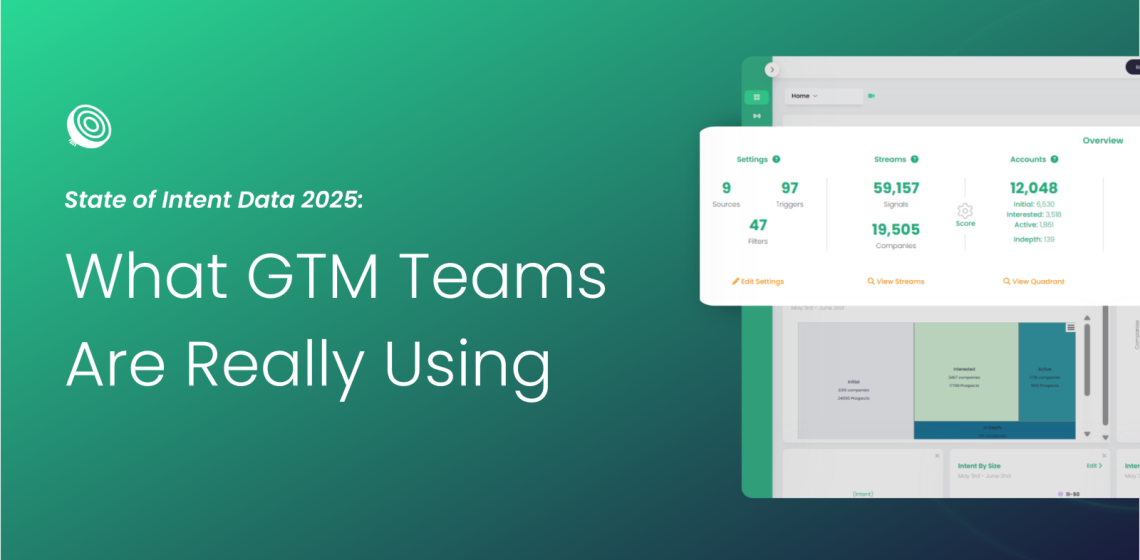In 2025, buyer intent data isn’t a “nice-to-have, it’s the core of every successful go-to-market engine. What once gave early adopters a competitive edge is now table stakes. GTM teams aren’t asking if they should use intent – they’re figuring out how to use it better, smarter, and more strategically.
This blog dives into how top-performing teams are activating intent data today, the platforms they trust, where challenges still exist, and how the landscape is shifting.
Intent Data Adoption Is Now the Norm
If your GTM strategy doesn’t include intent data, you’re already behind.
Over 70% of B2B GTM teams now use intent in their marketing programs, with 60% embedding it in sales workflows, and 54% applying it to customer success.
And it’s working:
- 96% of marketers say they’ve seen measurable success.
- 93% report improvements in conversion rates.
Whether it’s surfacing leads, aligning teams, personalizing campaigns, or preventing churn – intent data has become a core growth lever across the funnel.
The Intent Data Ecosystem: Who’s Who
The space is crowded – and getting more sophisticated by the day.
Leading players include:
- Bombora – Known for its Company Surge® and massive data co-op.
- 6sense – Offering predictive AI and dark funnel detection.
- Demandbase – ABM-focused orchestration with company-level insights.
- ZoomInfo – Intent topics tied to contact data for rapid activation.
- TechTarget – Publisher-first, contact-level signals.
- G2 & TrustRadius – Buyer intent based on review activity, often near purchase.
- Other providers making waves: Cognism, Anteriad, Leadspace, DemandScience, and LinkedIn.
How Leading Companies Activate Intent
Top GTM teams don’t just collect signals – they operationalize them.
Here’s how intent is getting turned into pipeline:
- Account Prioritization: Combining firmographics with intent spikes and buyer research data to score accounts and build outreach sequences.
- Campaign Orchestration: Dynamically launching campaigns across email, ads, and social the moment a topic surges.
- Sales Enablement: Feeding reps timely alerts with competitor mentions, research topics, and talking points that close deals.
- Real-Time Integration: Syncing data straight into CRMs and collaboration tools like Salesforce, HubSpot, and Slack.
The Friction Points Still Holding Teams Back
Despite its growth, intent data isn’t frictionless. Common challenges persist:
- Signal Accuracy: Especially with IP-based signals, misattribution can waste time and effort.
- Integration Complexity: Many teams struggle to plug intent into their tech stack seamlessly.
- Misinterpretation: Confusing interest (like blog views) with true intent (like product comparison).
- Privacy Pressures: With third-party cookies fading, first-party and consent-based data are essential.
- Vendor Overload: With so many overlapping platforms, GTM teams face redundancy and inconsistency.
Where We’re Heading: Intent in 2025 and Beyond
This year, the smartest GTM teams are focused on evolution, not just execution. These trends are shaping the future:
- Account, Person and Website-Based Intent Fusion: Combining web, CRM, and external sources for a 360º view of buying behavior.
- AI-Powered Orchestration: Automatically tagging topics, triggering plays, and scoring intent with machine learning.
- Allbound GTM: Merging inbound and outbound plays using unified signals.
- Revenue-Centric Attribution: Tracking ROI by pipeline and revenue – not vanity metrics.
- Cross-Team Adoption: Intent isn’t just for marketing and sales – product, success, and intelligence teams are tapping in.
- Platform Consolidation: The era of point solutions is fading. GTM leaders are choosing platforms that unify the signal stack.
Why Lead Onion Leads the Way
At the centre of this evolution is Lead Onion – a GTM Intelligence Platform designed to help teams turn signal chaos into strategic action.
.png)
Lead Onion pulls from 24+ real-time intent sources, then layers in account, person, and website-level intent to pinpoint buying groups that are ready right now. Its proprietary Research Surge™ and Intent Quadrant™ models categorize buyer readiness into actionable stages:
- Initial
- Interested
- Active
- In-Depth
…so GTM teams know exactly when and how to engage.
“Most platforms give you data. Lead Onion gives you direction.”
— Peter Eakin, Head of Sales, Lead Onion
With native integrations into Salesforce, HubSpot, Dynamics, Slack, and more, Lead Onion doesn’t just show you who’s in-market – it activates the next best action automatically across your stack.
The Bottom Line
Intent data has officially moved from experimental to essential. The most successful GTM teams in 2025 aren’t guessing. They’re acting – on real buyer signals, with smart automation, and a laser focus on revenue impact.
So, the question isn’t whether to use intent data.
It’s whether your platform can give you the accuracy, context, and activation needed to turn those signals into real, scalable growth.
With Lead Onion it can. Get started now.


.png)